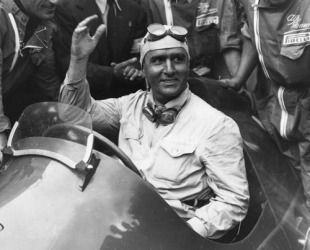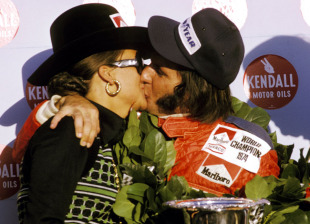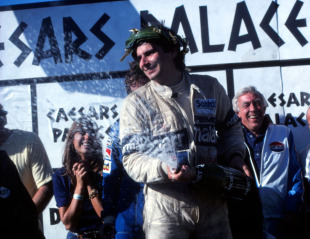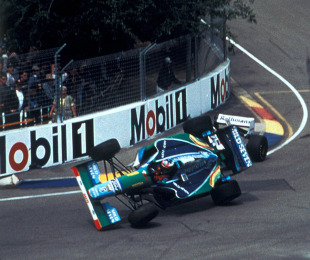- Top ten ... titles to go to the final race
Going down to the wire

- Drivers:
- Jim Clark
- |
- Luigi Fagioli
- |
- Juan Manuel Fangio
- |
- Nino Farina
- |
- Emerson Fittipaldi
- |
- Lewis Hamilton
- |
- Mike Hawthorn
- |
- Damon Hill
- |
- Graham Hill
- |
- James Hunt
- |
- Niki Lauda
- |
- Nigel Mansell
- |
- Felipe Massa
- |
- Stirling Moss
- |
- Nelson Piquet
- |
- Alain Prost
- |
- Clay Regazzoni
- |
- Carlos Reutemann
- |
- Michael Schumacher
- |
- John Surtees
- |
- Jacques Villeneuve
1950
The inaugural season of the FIA World Championship went down to the Italian Grand Prix at Monza, the last of six races. Thanks to wins at the previous two grands prix, Juan Manuel Fangio arrived in Italy as the leader, two points clear of Luigi Fagioli and four ahead of Nino Farina, whose early form had fallen away. As only the best four results of the season would count, Fagioli, with four seconds, could only take the title if he won and his Alfa Romeo team-mates both failed to finish. Fangio had three wins, so any finish would add to his tally, while Farina knew he had to win and even then hope Fangio finished no better than fifth. Fangio took pole ahead of Alberto Ascari, with Farina and Fagioli just behind them. The initial laps went the same way, Fangio leading Ascari's brand new Ferrari 375 - the 4.5-litre car that would break the dominance of the Alfas - and setting the fastest lap. Ascari briefly took the lead on lap 14 but was soon overhauled by Fangio, and then Ascari's rear axle broke and he limped into the pits and commandeered Dorino Serafina's car. Two laps later Fangio's gearbox seized and he took over his team-mate Piero Taruffi's vehicle, but ten laps later the engine blew and he was out. That left the field open for Farina who went on to finish a minute-and-a-half clear of Ascari and in so doing become the first Formula One world champion.
1958
A season marred by the death of Peter Collins ended with a gripping final race but another tragedy. Despite Stirling Moss having won three races to Mike Hawthorn's one, the dropped-score system favoured Hawthorn. Moss needed to win the race and set the fastest lap for a vital extra point and hope things behind him went his way. Moss led all the way and gained the vital point from the fastest lap, but Hawthorn eased into second when team-mate Phil Hill let him past, which was all he required to take the crown. Although Moss' win ensured Vanwall won the inaugural constructors' title, it was of little consequence as his team-mate Stuart Lewis-Evans crashed, dying of his injuries six days later. Hawthorn, 29, retired as champion but was killed in a road crash in January the following year.
1964
Three drivers went to the finale in Mexico City with a crack at the title. Graham Hill led on 39 points, John Surtees had 34 and outsider, the brilliant Jim Clark, 30. Hill was soon out of contention for points after a collision with Surtees' Ferrari team-mate Lorenzo Bandini, and Clark looked set to snatch title after leading throughout when, with two laps remaining, his Lotus suffered an oil leak and he was forced to retire. Surtees had worked his way through the field and was waved into second behind Dan Gurney by team-mate Bandini - it was enough to take the title from Hill. In so doing, he became the first man to be world champion on four wheels and two.

Clay Regazzoni and Emerson Fittipaldi arrived in Watkins Glen level on points, with Jody Scheckter still in with an outside chance of the title seven points back. Qualifying offered little, with none of them in the top five, and the race itself was soon overshadowed by the 10th-lap death of Helmut Koinigg, decapitated when his car hit the barriers. Regazzoni, meanwhile, was in all sorts of trouble and despite two pit stops, the Ferrari team were unable to get his car running as it should and it was never in contention. On the 44th lap, Scheckter's engine suddenly lost fuel pressure when a feed pipe broke and he was forced to retire, meaning Fittipaldi was champion for the second time in three years regardless of where he finished by virtue of the number of races he had won. As it was, he cruised home fourth.
1976
A finale to a season that had it all but which was ultimately settled by appalling weather. Niki Lauda and James Hunt had been battling hard all year, but the championship race appeared over when Lauda suffered life-threatening injuries at the Nürburgring in August. But against medical opinion he returned and with Hunt's win at Brands Hatch invalidated, it all came down to the Japanese Grand Prix at Fuji. Lauda had a three-point lead but so bad were the conditions he withdrew from the race in protest after one lap - despite his amazing return from horrendous burns and the fact he had one eye which he could not close, some questioned his courage. "There is a limit in any sport of profession," he said. Hunt led until near the end when he had to pit as his tyres were shredded, but he returned to take third and so edge out Lauda by one point.

Formula One arrived in the car park of the Caesar's Palace Hotel to decide whether Carlos Reutemann or Nelson Piquet would join the ranks of the sport's greatest drivers. Reutemann held a one-point lead ahead of the final round in Las Vegas and started as the favourite from pole position. However, handling problems during the warm-up soon manifested into a totally undriveable car in the race and he shed places, while team-mate Alan Jones, who had reluctantly agreed to help Reutemann if necessary, sped off into the distance. Piquet passed Reutemann on lap 17 and from that point onwards it became an endurance race with the anti-clockwise and tight circuit playing havoc with the drivers' necks. "I remember seeing there were still 33 laps to go," Piquet recalled. "I couldn't believe it. By then I was already finished. I couldn't keep my head straight. I just kept going because I knew if I was in front of Carlos then I had the championship." He eventually crossed the line fifth but on his returned to the pits he collapsed in the cockpit, vomiting. Nevertheless, he was the new world champion.
1986
With 20 laps of the Australian Grand Prix remaining, Nigel Mansell looked set to become the first British World champion in ten years. One lap later and he was fearing for his life as he tried to prevent his Williams from careering into a concrete wall. Mansell entered the final race leading the title race by six points from Alain Prost and Nelson Piquet. However, excessive tyre wear led to his almighty blow-out and brought his race and title chances to a dramatic end. "At that speed, self-preservation is all you have in mind," he said afterwards. With Williams fearing team-mate Piquet would suffer a similar or worse fate, it pitted the Brazilian and handed victory and the title to Prost and McLaren. Mansell was resolute and particularly patriotic in defeat: "I promise you I'll bounce back. I'm British."

Michael Schumacher snatched the first of his seven world championships in Adelaide, but did so in a manner that tainted his reputation in the eyes of many observers. He arrived in Australia one point ahead of title rival Damon Hill, knowing that if he finished ahead of the Williams he would become the first German world champion. However, lingering at the back of his mind, was the understanding that if both failed to finish he would still take the title. He started off pursuing Plan A but it fell apart on lap 35 when he ran wide and slammed against the wall. With his car heavily damaged and Hill closing in, he quickly switched to Plan B by attempting to block the Williams from passing. The two touched, Schumacher was out on the spot, and Hill returned to the pits with a bent wishbone. Minutes later and he was out of the race, handing the title to Schumacher. With Ayrton Senna's death still fresh in the mind, Alan Henry of the Guardian wrote: "Perhaps it was inevitable that an already tarnished season should end with what many observers here regarded as more than a hint of disreputable driving."
1997
Three years later and Schumacher found himself in a familiar situation. Once again he led the title battle by a single point into the final round and once again he saw his race lead come under attack from his title rival. This time it was Jacques Villeneuve in the Williams attempting to squeeze up the inside, but Schumacher's tactics were the same. He quite visibly turned his Ferrari into the side of Villeneuve, although he was a fraction of a second too late on this attempt and his car bounced off and into the gravel. Schumacher's race was over and, exactly as he had done in Adelaide in 1994, he watched from the behind the Armco to see if the Williams was still running. It was. Villeneuve went on to secure third in the race and take the championship, while Schumacher was later stripped of all his championship points by the FIA.
2008
The closest title battle of all time came down to the final corner, of the final lap, of the final race. So close was the contest that both challengers, Lewis Hamilton and Felipe Massa, were celebrating as they crossed the line. Needless to say the winner was Hamilton, who needed to finish fifth but dropped to sixth in wet conditions towards the end of the race. As he exited the final corner before the long slog up Interlagos' pit straight, he came across Timo Glock's Toyota struggling for grip on dry tyres. On his intermediates he powered past it and, unbeknown to the celebrating Ferrari pit crew, crossed the line to become world champion at the same circuit where he had failed by a point the year before. "My heart was in my mouth," Hamilton said. "I was almost exploding. I don't know how I did it. I was very fortunate." Massa, meanwhile, was distraught: "I don't cry a lot, but today it was difficult not to."

